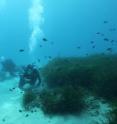A toxic menu
Related images
(click to enlarge)
In a study published in the journal Proceedings of the National Academy of Science, scientists from the Max Planck Institute for Marine Microbiology in Bremen and Greifswald University, together with colleagues from Freiburg, Italy and the USA, have revealed that a small marine worm, faced with a scarce food supply in the sandy sediments it lives in off the coast of Elba, must deal with a highly poisonous menu: this worm lives on carbon monoxide and hydrogen sulphide. The worm, Olavius algarvensis, can thrive on these poisons thanks to millions of symbiotic bacteria that live under its skin. They use the energy from carbon monoxide and hydrogen sulphide to produce food for the worm. The symbionts do this just like plants by fixing carbon dioxide into carbohydrates but instead of using light energy from the sun, the symbionts use the energy from chemical compounds like carbon monoxide. "They do this so effectively, that the worm has lost its entire digestive system, including its mouth and gut, during the course of evolution, and feeds only through its symbionts," explains Nicole Dubilier, Head of the Symbiosis Group at the Bremen-based Max Planck Institute.
Carbon monoxide and hydrogen sulphide, however, are by no means the only energy sources this worm can live on. Some of the symbiotic bacteria in the worm can take up hydrogen and organic nutrients from the environment, even if these are present in only tiny amounts. Olavius algarvensis also has other tricks up its sleeve that allow it to survive in its nutrient-poor environment: in contrast to most animals, which are not capable of recycling their waste products and must excrete them, the worm can make further use of these, again thanks to its symbiotic microbes. The symbionts are true recycling masters when it comes to use products that still contain a lot of energy for their own purposes, but are no longer any use to the worm. "This is the reason why the worm has been able to not only reduce its digestive system, but also its kidney-like excretory organs," stresses Dubilier, "something that has not been discovered in any other marine animal."
For their investigations, the researchers used a combination of cutting-edge techniques, such as metaproteomics and metabolomics, which make it possible to analyse a large proportion of the proteins and metabolic products in an organism. Metaproteomic analysis presented a particular challenge, as it required the researchers to separate the cells of the symbionts and the host. Thomas Schweder from the Institute of Pharmacy at Greifswald University explains: "Using metaproteomics, we were able to identify thousands of proteins and assign them to the individual partners in the symbiosis. This gave us direct insights into the metabolism of the bacterial symbionts and their interactions with the host."
The researchers were very surprised when their analyses revealed that the worm has large amounts of proteins that allow it to use carbon monoxide as an energy source, because this gas is so poisonous. "Also, we couldn't imagine that carbon monoxide is present in the worm's environments," says Manuel Kleiner, a doctoral student in Nicole Dubilier's research group, "so we were amazed to find such unusually high concentrations of carbon monoxide in the Elba sandy sediments."
Nicole Dubilier has been working with the worm for more than 15 years: "We have known for quite some time that the symbiotic bacteria in Olavius algarvensis can interact with one another to use the energy-rich sulphur compounds to gain energy." But it is only now that the researchers have been able to work out other metabolic pathways -- and to discover new energy sources. The study highlights the importance of complementing metagenomic analyses with metaproteomics and metabolomics. "The worm provides us with an example of the power of evolution. Over the course of millions of years, adaptation and selection have led to the development of an optimally adapted host-symbiont system. And these seemingly modest worms are an excellent model for a better understanding of other complex symbioses, such as those of the human gut," says Dubilier.
Source: Max-Planck-Gesellschaft
Other sources
- A toxic menu: Marine worm feeds on carbon monoxide and hydrogen sulphide with the help of symbiotic bacteriafrom Science DailyTue, 17 Apr 2012, 20:30:31 UTC
- Toxic menu: Marine worm feeds on carbon monoxide and hydrogen sulphide with the help of symbiotic bacteriafrom PhysorgTue, 17 Apr 2012, 17:30:41 UTC
